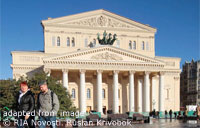Bolshoi’s ‘Rite of Spring’ Festival Goes On Despite Turmoil

(Moscow Times – themoscowtimes.com – Raymond Stults – March 26, 2013)
Despite the turmoil following the attack in mid-January on Bolshoi ballet artistic director Sergei Filin, the theater has continued without hesitation to follow the age-old precept “the show must go on.” And this week it promises to do so with still greater intensity when it opens a four-week-long festival, “Century of ‘The Rite of Spring’ Century of Modernism,” dedicated to the 100th anniversary of the first performance of the ballet by Igor Stravinsky known in Russia as “Vesna Svashchennaya” (Holy Spring).
The festival begins on Thursday with the Bolshoi’s own new version of “The Rite,” in choreography by Tatyana Baganova, artistic director of Yekaterinburg’s highly acclaimed Provincial Dances Theater. Next come companies from Switzerland and Germany, each with a setting of the ballet that has achieved near-classic status.
And to close the festival, Helsinki’s Finnish National Ballet will appear in a reconstruction of the choreography by legendary dancer Vaslav Nijinsky that was seen at the ballet’s first performance a century ago.
The premiere of “The Rite,” which took place on May 29, 1913, as part of impresario Sergei Diaghilev’s fifth Saison Russe in Paris, was like no other in the history of ballet, turning the Theatre des Champs Elysees into a madhouse. Shouts and catcalls were heard from practically the moment the curtain went up, fights broke out among the audience and police were eventually called in to quell the disorder.
The story of “The Rite,” as devised by Stravinsky and artist Nikolai Rerikh, who created the original sets and costumes, concerns an ancient pagan ritual that ends in the sacrifice of a young maiden.
Stravinsky’s score is harsh, dissonant and unrelentingly rhythmic. Underlying it are folk melodies collected by the composer from various parts of the Russian Empire.
“Stravinsky [then] proceeded to pulverize them into motivic bits, pile them up into layers, and reassemble them in cubistic collages and montages,” wrote American critic Alex Ross.
For its own version of “The Rite,” which will be performed March 28 to 31, the Bolshoi initially engaged British choreographer Wayne McGregor, whose ballet “Chroma” counts as probably the most choreographically advanced work in the theater’s dance repertoire. But shortly after the attack on Filin, McGregor asked to postpone the engagement until after Filin’s return to the Bolshoi.
As a result, the Bolshoi turned to Baganova, widely regarded as Russia’s leading contemporary dance choreographer. Baganova has never before worked with a large, classically trained troupe like the Bolshoi’s or been faced with creating a complicated ballet in the absurdly short space of less than two months. Nevertheless, to judge by her remarkable achievements with her own Yekaterinburg company, it seems fair to expect that she will come up with a staging of real quality and originality.
Next up on the festival program (April 4-7) will be Ballet Bejart Lausanne, with a setting of “The Rite” created in 1959 by the company’s revered founder, Maurice Bejart, who died six years ago. Bejart’s version is famous for its eroticism, its culminating sacrifice described by one observer as being replaced by “ceremonial coitus.”
Appearing third at the festival (April 11-14) will be Tanztheater Wuppertal Pina Bausch, from Germany, a troupe that has enjoyed enormous success in it previous Moscow appearances. Its version of “The Rite,” created in 1975 by the troupe’s late founder, Pina Bausch, stands in stark contrast to that of Bejart. Danced on a stage covered with soil, it presents the ballet as a ritual filled with violence and terror.
The Finnish National Ballet closes the festival (April 18-21) with its reconstruction of “The Rite” as a Parisian audience saw it on its tumultuous first night in 1913.
“The Rite” lasts just over 30 minutes. To fill up the evening, the Bejart company has added two other works by its founder and one by its current director, Gil Roman.
The Pina Bausch company shows a documentary film devoted to the choreographic achievements of its founder and the Finnish visitors present a mixture of other ballets from their repertoire, including one by the eminent Czech-born choreographer Jiri Kylian.
The Bolshoi also has a very special treat in store to accompany “The Rite of Spring” the first staging in Russia of a ballet by the renowned Swedish choreographer Mats Ek. Titled “Apartment” and created in 2000 for the Paris Opera Ballet, the work concerns itself with banal objects of everyday life a stove, a door, a vacuum cleaner, a TV set and even a bidet for the purpose of showing our living quarters as the place where our lives unfold and, at the same time, where we are separated and isolated from the world outside.
Dancing in “Apartment” will be some of the Bolshoi troupe’s brightest lights, as well as guest prima ballerina of the Mariinsky Theater, Diana Vishneva.
The “Century of ‘The Rite of Spring’ Century of Modernism” runs from March 28 to April 21 at the Bolshoi Theater, located at 1 Teatralnaya Ploshchad. Metro Teatralnaya. Phone: +7 495-455-5555. www.bolshoi.ru.
